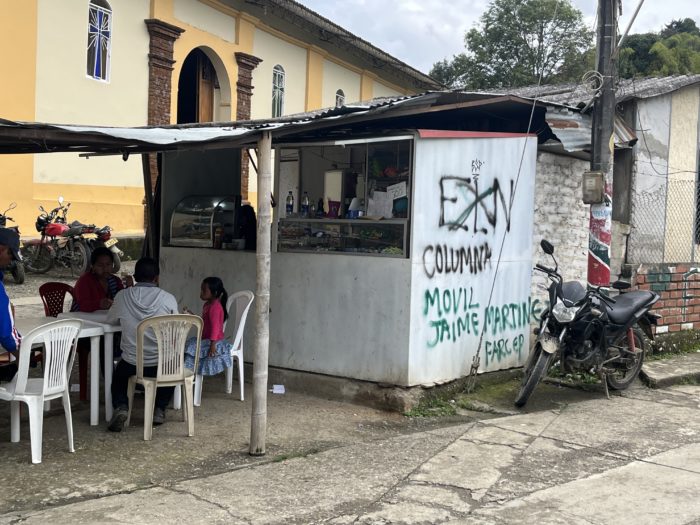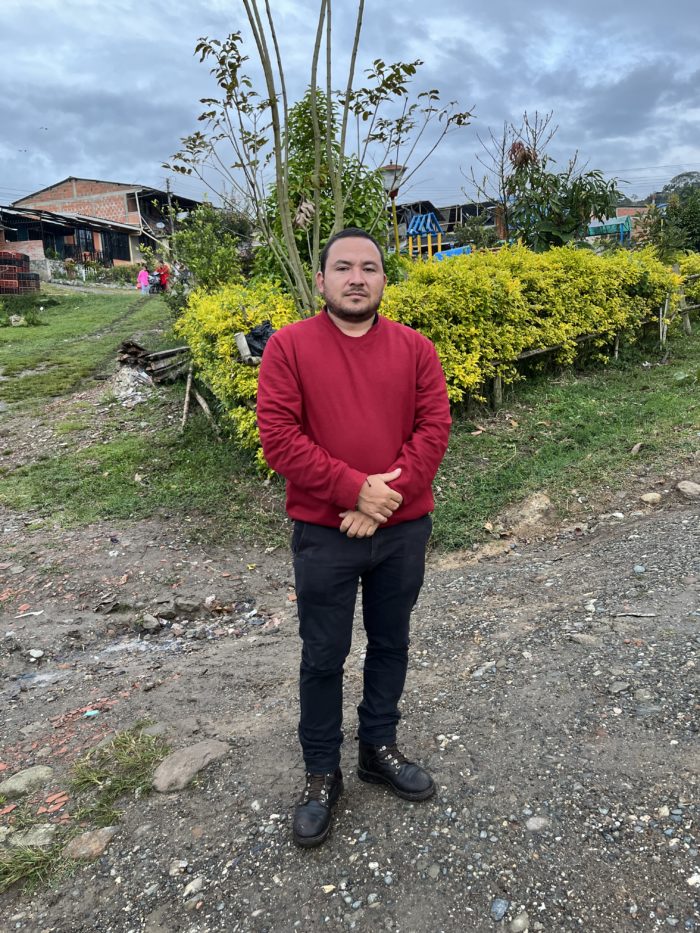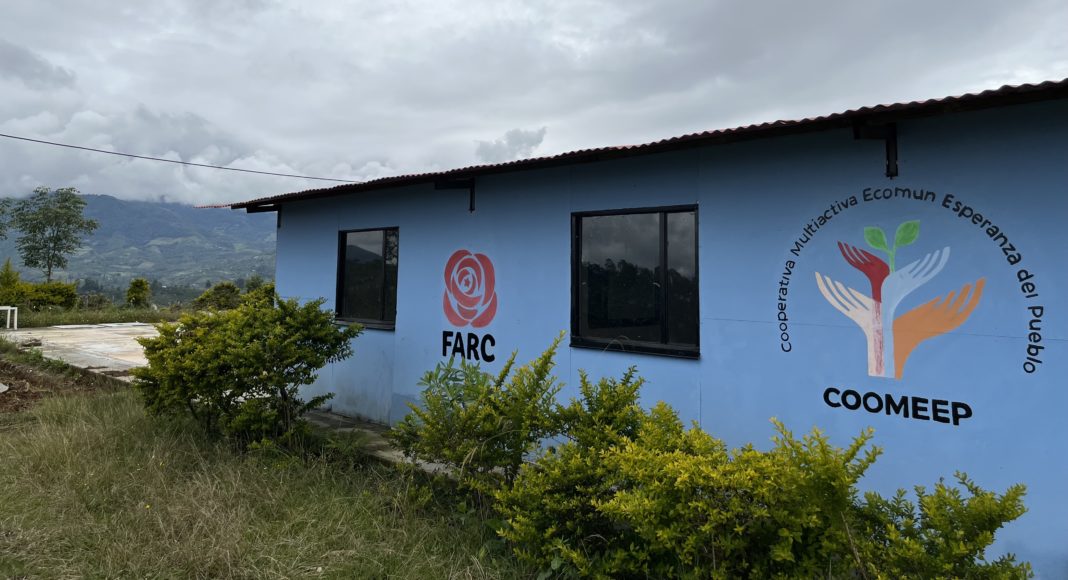In one of the towns that has suffered most from the Colombian conflict, Lewis Harrison spoke to locals including the mayor, a Senator, demobilized FARC guerillas, the leader of the local victims’ association, and the town’s human rights ombudsman, about the prospects for peace under new President Gustavo Petro, who recently launched talks with the country’s largest remaining guerrilla group, the ELN.
At first glance, there is little sign of the war that quietly rages in Caldono, a small town in Cauca department. The graffiti offers the first clue. The initials of Colombia’s two main guerrilla groups, the FARC and the ELN, are emblazoned on walls and road signs, often scrawled on top of each other in a reflection of the underground conflict that continues to take a heavy toll on the town six years after the signing of a peace agreement.
Peace swiftly proved to be an illusion in Cauca; while most FARC rebels laid down their weapons, dissident units broke away to continue battling over the drug trafficking routes that funded their insurgency.
‘It’s not a very public situation – you look at the area and it seems calm. But at any moment it can change,’ said Dany Anacona, Caldono’s human rights ombudsman. ‘There is no direct struggle against the state, the deaths are caused by armed groups fighting to control territory, and those who die are young – mostly between 14 and 19 years old.’ Young men and teenagers are slain on an almost weekly basis in this municipality of 34,000 people, sometimes for refusing to be recruited into the rebel groups.
This was not how most residents had pictured their future in 2016, when Caldono was held up as one of the towns that stood to gain the most from the peace agreement. According to Colombia’s Truth Commission, Caldono was the second-most attacked town in the conflict, suffering 248 attempted takeovers by the FARC between 1997 and 2014. Lying in a strategic position next to the Pan-American highway and with easy access to the Pacific coast, the FARC saw control of Caldono as vital to protecting its cocaine shipments. Many of its assaults were indiscriminate, with Caldono’s position at the bottom of a steep valley making it vulnerable to mortar attacks.

In that sense, at least, things have improved. Clashes still break out in Caldono’s rural outskirts, with the most recent outbreak of serious fighting forcing residents to remain in their homes for three days in late September. Anacona noted, however, that this violence ‘was carried out with rifles, not like before when there were mortars and car bombs.’
Upstairs in his office overlooking the town square, Caldono’s mayor, Vicente Otero, was mulling over the murder of a man whose body was found on a nearby hillside that morning. Otero had little doubt that he fell victim to one of the three rebel groups operating around his town. ‘As there are two dissident groups here, plus the ELN, which are all recruiting young people, we’ve had cases where members of the same family have ended up on different sides,’ Otero said. At the same time, ‘common criminals are taking advantage of the war between rebel groups to steal, to extort, pretending that they are from a certain group.’ Asked whether things have improved since the FARC laid down its weapons, Otero hesitated. ‘Things have changed since the demobilization, but we still can’t talk about a post-conflict,’ he said. ‘Caldono currently has very high levels of violence, and hasn’t taken that step from conflict to post-conflict’.

If Caldono remains trapped between the horrors of the past and the promise of the future, few dispute that economic factors lie at the root of its problems. For decades, this poor agricultural region was isolated by the conflict, which prevented infrastructure improvements needed to bring farmers’ produce to profitable markets. The FARC’s demobilisation saw some money arrive in town. But even now, Otero said, ‘it’s easier for a farmer to produce a kilo or two of coca than a ton of bananas that no one’s going to buy’.
Across Colombia, frustration at poverty, inequality and violence was a key factor in the election in June 2022 of the country’s first left-wing president, Gustavo Petro. Petro took 86 per cent of the vote in Caldono with a promise to secure ‘total peace’ by negotiating ceasefires with all armed groups, redistributing land, and boosting rural investment. For many in the areas worst-affected by the conflict, Petro’s victory was a cause for hope after four years in which his predecessor, Iván Duque, was widely accused of slow-walking the implementation of the peace deal.
Speaking 10 days after suffering an assassination attempt on 29 October in which her car was shot at by unidentified assailants, Aida Quilcué, an Indigenous senator for Cauca department, laid the blame for the continued political violence squarely with the Duque administration. ‘Duque didn’t comply with the peace agreement, he undermined it and committed himself to war,’ she said, emphasising that ‘peace isn’t just about silencing the guns, it’s about resolving extreme poverty’.

Negotiations with the ELN were formally launched on 21 November, and will present the first real test of Petro’s peace plans. Progress is likely to be slow – the ELN has now negotiated with no fewer than seven presidents without agreeing to a demobilization, and on 3 January the group rebuked Petro for prematurely announcing that an agreement had been reached on a ceasefire.
Farid Julicué, the leader of the Caldono victims’ association, believes that an agreement will be reached – although, having spent most of his 72 years documenting the ebb and flow of the war around his town, he is sure that some ELN units will refuse to give up arms. However, he remains doubtful that any government could end Colombia’s conflict. ‘Peace must be born here,’ he said. ‘There are still people who think that peace is made in Bogotá with a government decree – when things are planned on the top floor of a building in Bogotá, they stay on that top floor and don’t reach us’. Arguing that reconciliation is needed between victims and former FARC guerrillas, Julicué insisted that ‘the day we’re capable of forgiving is the day that there will be peace’.
For the former guerrillas for whom he is preaching forgiveness, life outside the FARC can be a dangerous existence. Since 2017, when the FARC demobilized, 329 ex-combatants have been murdered – by neo-paramilitary groups, vigilantes, or former guerrilla comrades. These killings not only risk causing ex-rebels to question whether they would be safer taking up arms again, but also suggest to active members of armed groups that demobilisation would entail a lifetime looking over their shoulder. Francisco*, a former FARC guerrilla working in Caldono, lives under a perpetual state of threat after getting into a dispute with a dissident unit which has already tried to kill him once. ‘I know that at any moment something could happen to me,’ he said. ‘Our thinking when we began the peace process was that we would enter civilian life and form a political party – we never thought that this would happen.’
Francisco fears that a similar process will unfold if the ELN agrees to lay down arms. Like most of his former comrades, he blames the previous government for failing to uphold its side of the deal. ‘Petro needs to learn from what happened with the FARC’ he said. ‘To deliver total peace he needs to deliver social investment, such as arranging free university tuition to enable young people to study. Because at the moment, when a 16-year-old boy living in a conflict zone leaves school without that opportunity, people come and whisper in his ear and he goes away with them to die’.
Jhan Carlos Moreno, another demobilized guerrilla now leading a collective of former rebels in Caldono, was more circumspect. Viewing the 2016 peace agreement as a starting point, Moreno emphasized that Colombia has been in varying states of civil war for much of the period since it gained independence in 1810. ‘Building peace in six years was never going to be possible for a society that has spent 200 years in conflict,’ he said. In Moreno’s view, the ongoing violence has little to do with politics, and reflects a trauma in Colombia’s national psyche. Peace, he said, is ‘a matter of building trust in a country that has lost all trust… Colombia needs psychological help, because we have an irreversible fear that will take many generations to disappear’.
Lewis Harrison is Andean Editor at LatinNews. This piece was researched during a freelance reporting trip in southwest Colombia.

